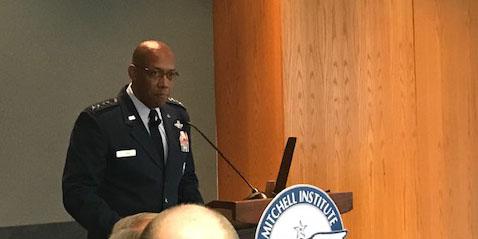Air Force Leader Looks to a 5th Generation Mindset for the Indo-Pacific
The U.S. Air Force’s role in the Indo-Pacific region of the world is complex given the current atmosphere and threat environment. The region is host to 44 percent of the world’s trade and 60 percent of the world’s population. And for the United States, four of the five major challenges and threats identified by the National Defense Strategy and the National Security Strategy are in the Indo-Pacific region, including revisionist powers China and Russia, said the commander of the U.S. Pacific Air Forces, Gen. Charles Brown. The four-star general, whose area of responsibility is the Indo-Pacific, is also air component commander for the U.S. Indo-Pacific Command; and the executive director, Pacific Air Combat Operations Staff, Joint Base Pearl Harbor-Hickam, Hawaii.
“We believe in a free and open Indo-Pacific with a safe, secure and prosperous region, free of coercion … with the ability to fly, sell and operate anywhere international law allows,” he stated yesterday at the Mitchell Institute for Aerospace Studies in Arlington, Virginia.
Accordingly, the regional strategy of the Pacific Air Forces, or PACAF, centers on agility, resilience and long-term strategic competition, he said. Essentially, China is the PACAF’s primary focus. The command is keeping a close eye on North Korea and, with help from the U.S. European Command and Northern Command, PACAF is watching Russian activities, the general noted.
The episode last week, in which China and Russian bomber aircraft were reportedly patrolling the Sea of Japan and the East China Sea together, raises clear concerns for the United States, Gen. Brown said. “I do pay attention to that,” he explained. “That's why when I talk about great power competition, China is our priority, but I also pay attention to Russia. I do see the potential for them to start operating together.”
Growing the U.S. military’s resilience, including fostering its relationships with allies and partners, is crucial to combat this type of environment, the commander said.
“The first line of effort, and really I think quite possibly the most important line of effort, is strengthening alliances,” Gen. Brown said. “In both conflict and cooperation, we aren't alone. We work with our allies and our partners by uniting our mutual values, interest in security, and preservation of peace and stability in the region.”
The U.S. military is continually assessing partner nations in terms of alignment of mutual interest, capabilities and interoperability. “I believe every training event, every key leader engagement, is an opportunity to demonstrate excellence,” he continued. “The second line of effort we’ve focused in enhancing lethality and operability, through exercises and training. Our airmen engage in a number of exercises throughout the course of the year. We have about 40 different exercises, from kind of the high end to [smaller] events. … It runs the full spectrum.”
Across all of the services, the U.S. military is focusing on improving interoperability, and PACAF is no different, Gen. Brown explained. However, it is not such a simple undertaking, as there are different degrees of compatibility, depending on the ally.
“It's really important that we leverage the capabilities that they have,” he said. “And as we look to our partners, we also recognize that there are varying levels of interoperability. It ranges from just having the same aircraft and equipment, to actually having the same aircraft, same equipment, and the same tactics, techniques and procedures, where we can operate and execute seamlessly.”
The F-35 platform will be a key uniting factor amongst U.S. allies, the commander noted. Already, the Indo-Pacific region has 30-35 of the advanced aircraft in place, and by 2025 that count will grow to 220, with the U.S. Marine Corps, Japan, Australia and South Korea as key F-35 partners. The U.S. Air Force will begin fielding the advanced aircraft to the region over the next year, he added.
“[When] we do all the math, the key part of this is that 70 percent of the F-35s in the Indo-Pacific will be owned by a partner, not by the United States,” Gen. Brown said. “So to me, that's why interoperability and how we work with our partners will be really important as we get on that path of the 5th Generation mindset.”
Having F-35 and F-22 aircraft in the Indo-Pacific region is only part of employing 5th Generation Warfare, the general said. “To me, it's kind of changing the mindset of how we integrate that into operations,” he said. “So I'm developing a vision for a 5th Generation Air Force Mindset. It's based on concepts like agile combat employment, or ACE.”
That mindset will have to include recognition of reduced airborne communications in heightened conflicts. “I can guarantee we'll be contested, and we'll have degraded communications that we will have to deal with.”
In order to maintain advantage of the U.S. Joint Force, our military will have to instill doubt in the mind of adversaries, Gen. Brown advised. This means having the ability to move capabilities around fairly quickly, not only in airborne components, but in the marine, maritime and land-based environments as well, he continued. “[We’ve got to be able] to move very quickly and distribute our capabilities so not everything is at risk,” the commander stated. “If I can operate from every airfield that has the ability to support ISR [intelligence, surveillance and reconnaissance] … then my adversary has to account for that, and so that's one of my goals.”
In addition, the general highlighted the role of small groups of multifunctional airmen to increase capabilities in the region. However, this kind of agile force that can generate airpower from multiple locations requires kind of a different kind of command and control (C2). “And it will require some advanced planning concepts and logistical supply lines to make sure that we're lean, agile and connected,” Gen. Brown noted.





Comments